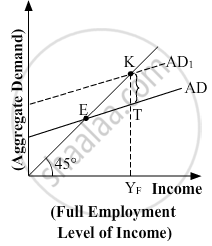Advertisements
Advertisements
प्रश्न
We suppose that C = 70 + 0.70Y D, I = 90, G = 100, T = 0.10Y (a) Find the equilibrium income. (b) What are tax revenues at equilibrium Income? Does the government have a balanced budget?
उत्तर
(a) C = 70 + 0.70 YD
I = 90
G = 100
T = 0.10Y
Y = C + I +G
Y = 70 + 0.70Y + 90 + 100
Y = 70 + 0.70YD + 190
Y = 70 + 0.70 (Y − T) + 190
Y = 70 + 0.70Y − 0.70 × 0.10 Y + 190
Y = 70 + 0.70Y − 0.07Y + 190
Y = 70 + 0.63Y + 190
Y = 260 + 0.63Y
Y − 0.634 = 260
0.37Y = 260
`Y = 260/0.37`
Y = 702.7
(b) T = 0.10Y
= 0.10 × 702.7
= 70.27
Government expenditure = 100
Tax revenue = 70.27
As, G > T, Government has a deficit budget, not a balanced budget.
APPEARS IN
संबंधित प्रश्न
Fiscal deficit equals :
(a) Interest payments
(b) Borrowings
(c) Interest payments less borrowing
(d) Borrowing less interest payments
Define fiscal deficit
Give the relationship between the revenue deficit and the fiscal deficit.
Suppose that for a particular economy, investment is equal to 200, government purchases are 150, net taxes (that is lump-sum taxes minus transfers) is 100 and consumption is given by C = 100 + 0.75Y (a) What is the level of equilibrium income? (b) Calculate the value of the government expenditure multiplier and the tax multiplier. (c) If government expenditure increases by 200, find the change in equilibrium income.
Consider an economy described by the following functions:- C = 20 + 0.80Y, I = 30, G = 50, TR = 100, calculate the effect on output of a 10 per cent increase in transfers, and a 10 per cent increase in lump-sum taxes. Compare the effects of the two.
What do you understand by G.S.T?
Answer the following question.
In the given figure, what does the gap 'KT' represent? State any two fiscal measures to correct the situation.

Fiscal deficit = ______.
Which of the following statement is true?
| S. No. | Content | Rs (in crores) |
| 1. | Revenue Expenditure | 100 |
| 2. | Capital Receipts | 40 |
| 3. | Net Borrowings | 38 |
| 4. | Net Interest Payments | 27 |
| 5. | Tax Revenue | 50 |
| 6. | Non-tax Revenue | 15 |
Which of the following is the formula for revenue deficit?
| S. No. | Content | Rs (in crores) |
| 1. | Revenue Expenditure | 100 |
| 2. | Capital Receipts | 40 |
| 3. | Net Borrowings | 38 |
| 4. | Net Interest Payments | 27 |
| 5. | Tax Revenue | 50 |
| 6. | Non-tax Revenue | 15 |
Which of the following is MOST LIKELY to be the main contributor to the fiscal deficit in this case?
Which of the following statements are correct
Statement 1: Fiscal deficits are not necessarily inflationary; though, they are generally regarded as inflationary.
Statement 2: When the government expenditure increases and tax reduces, there is a government deficit and there will be a corresponding increase in the aggregate demand.
How do we get the primary deficit from the fiscal deficit?
Which of the following statements is true?
Primary deficit is borrowing requirements of government for making:
Fiscal Deficit equals:
On the basis of the given information, calculate the value of:
- Fiscal deficit
- Primary deficit
| S.No. | Items | 2021-22 (₹ in crore) |
| (i) | Revenue Receipts | 20 |
| (ii) | Capital Expenditure | 15 |
| (iii) | Revenue Deficit | 10 |
| (iv) | Non-debt creating capital receipts | 50% of revenue receipts |
| (v) | Interest Payments | 4 |
